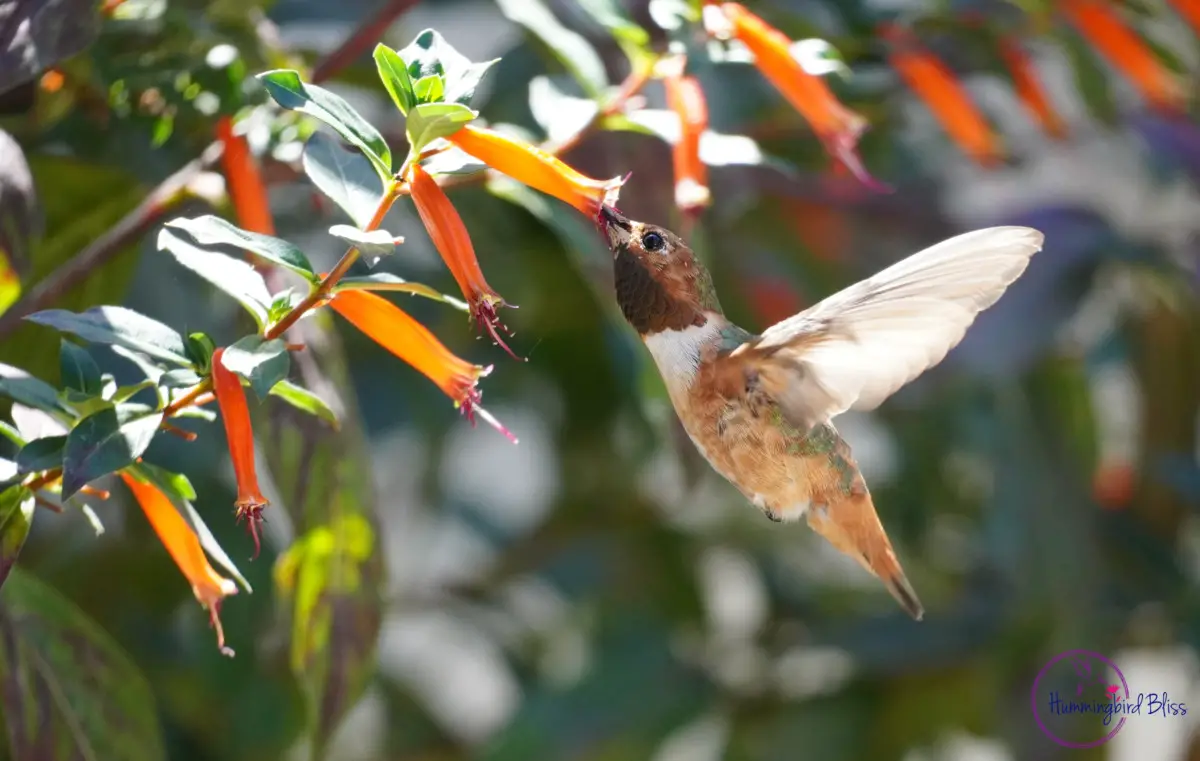This post contains affiliate links.
Hummingbirds are the most powerful aviators in the sky.
They achieve this status through consuming high quality nectar and protein for energy and muscle strength.
One would be surprised at the hummingbird’s consumable array of delectable items on their menu.
What Do Hummingbirds Eat?
Nectar and protein.
Nectar helps to supply the hummingbird with the energy demands required to perform its daily activities.
Hummingbirds get nectar from flowers or feeders.
They consume thousands of insects daily for protein to maintain the muscles required to seek out nectar sources.
Daddy-Long-Legs are a favorite.
Hummingbirds consume nectar and insects to obtain their body’s main nutritional dietary needs. The simple sugars in natural nectar from flowering plants or hummingbird feeders provide instant, sufficient and desirable energy. However, dozens to thousands of insects such as gnats, mosquitoes, and spiders are also eaten every day for protein.
As a speedy and powerful vessel flying through the mid-air, these tiny hummingbirds must make sure their food intake matches their high metabolism.
To be the most powerful aviator in the sky, hummingbirds must acquire their strength and stamina through obtaining desirable high-quality nourishment in a relatively small geographical space that has an enormous quantity of readily available food.
See my article: Hummingbird Adaptation and Remarkable Ability to Locate Food
What Nectar Do Hummingbirds Eat?
Hummingbirds prefer natural or homemade nectar with a concentration of 1:4 ratio of sugar:water.
This recommended sugar-to-water ratio mimics what is naturally found in their favorite flowers.
It is also the sugar-to-water ratio recommended for homemade hummingbird feeder nectar.
The simple digestible sugars found in nectar provide hummingbirds the quick and necessary fuel to sustain their extremely high metabolism and kinetic daily activities of eating, defending territories, and mating rituals.
See my article: Forget Commercial Hummingbird Food Try Making Homemade Nectar
Hummingbirds actually do not live off of sugar water or nectar alone. They need vitamins, fats and proteins to complete a nourishing well-balanced diet. Hummingbirds are amazing creatures and are able to adapt to their habitat better than most birds.
How Do Hummingbirds Get Protein?
Hummingbirds get their protein daily by eating dozens to thousands of insects consisting of midges, ants, aphids, beetles, caterpillars, gnats, flies, flying ants, fruit flies, insect eggs, leafhoppers, mites, mosquitoes, small beetles, spiders, wasps, weevils and whiteflies.
Daddy-Long-Leg spiders are one of their favorites.
If you are curious as to the size and shape of a midge as I was, a midge’s body size and shape are similar to that of a mosquito. Midge’s cluster in swarms and are usually seen hovering just above the grass in many backyards and open fields.
Here is a clip of a hummingbird waiting patiently on a branch. You can actually see the hummingbird’s beak open wide in anticipation of catching an insect.
The protein that is consumed from insects sustains and supports the hummingbird’s wing muscles to make them remarkably strong and aerodynamic flyers.
A hummingbird’s ability to maintain high powered endurance levels gives them an advantage when protecting their territory, hovering for long periods of time as they gather nectar, catching bugs in mid-air or displaying a mating dance to show their desired biological traits.
Hummingbirds and spiders have a symbiotic relationship. As much as hummingbirds enjoy eating them, they especially like to raid the spider web of its silk when constructing a hummingbird nest. They pluck live spiders or bug carcasses out of the center of the web for a snack.
See my article: Hummingbird Parents: (Mating to Nesting)
On the other hand, spiders have also been known to catch a hummingbird in their web and can keep it captive like a prisoner to eat for later!
Here is a video of a hummingbird caught in a spider web. Luckily there was a hummingbird enthusiast who untangled him, saved his life and released him back out into the wild!
Another useful way of providing an easily attainable protein meal is to start a compost that attracts bugs hummingbirds like to eat.
Any of your leftover fruits and vegetables that you have accumulated after a meal will provide the perfect ingredients to get you started. I like to keep a small container with a sealed lid near the kitchen sink to add all of my table scraps. Once the container is full, I dump the bucket into the compost heap outside.
Layering your compost with wet food items and dry items such as small twigs, leaves or grass clippings provides the perfect environment to attract worms and fruit flies.
The benefits of composting simultaneously creates soil for a potential garden, saves the environment and provides easy nutritious snacks for our hummingbird companions.
What Shape of Flowers Attract Hummingbirds?
Hummingbirds prefer long tubular shaped flowers because their long beak and tongue can reach the base where most of the nectar is stored.
Since hummingbirds rely on their vision when locating nectar, the tubular shaped flowers which hold the most nectar are the first intentionally searched nectar source.
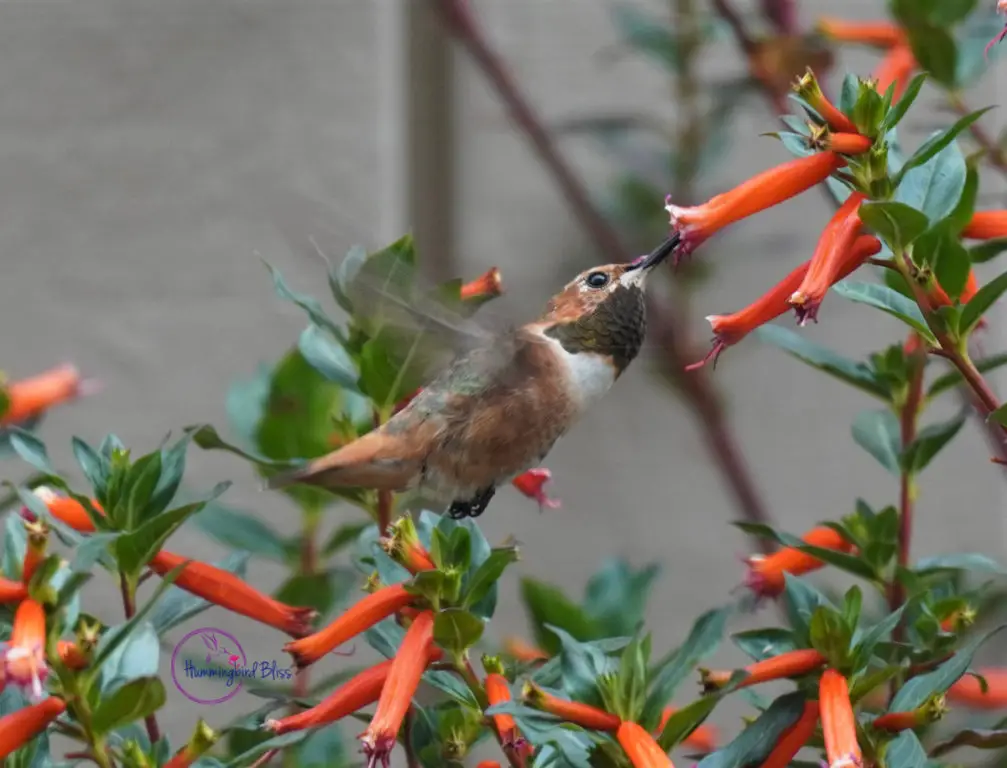
Cigar Plant – Cuphea ignea
The same flowers are accessed by large or diverse nectar consuming insects; however, the size or shape may not harmonize well to gather nectar at the base of the tubular flower as it is for hummingbirds.
Insects rely heavily on over saturated nectar production that drips down these tubular shaped flowers enabling them to lap the easily available nectar on the surface.
Therefore, these tubular shaped flowers are the essential private dining room for hummingbirds.
What Flower Colors Attract Hummingbirds?
Hummingbirds are attracted primarily to the color red with orange being a close second. They can also to a lesser degree be attracted to color combinations of pink, purple, white, blue and even shades of yellow. Tubular shaped red flowers are the primary attractant and desirable flowers for hummingbirds.
Hummingbirds see colors in the warm and cool UV (ultra-violet) spectrum. They can see the colors that humans can see except in their world the colors are brighter and more vivid.
Warm ultra violet colors such as red, orange, pink, peach, purple and yellow provide sweeter nectar.
Cooler ultra violet colors such as violet, blue and white produce nectar that is less sweet.
In nature, there is a greater abundance of warm colored flowers than the cool colored flowers. For survival, hummingbirds instinctively forage for red, tubular flowers that provide a sweeter and higher quantity of nectar.
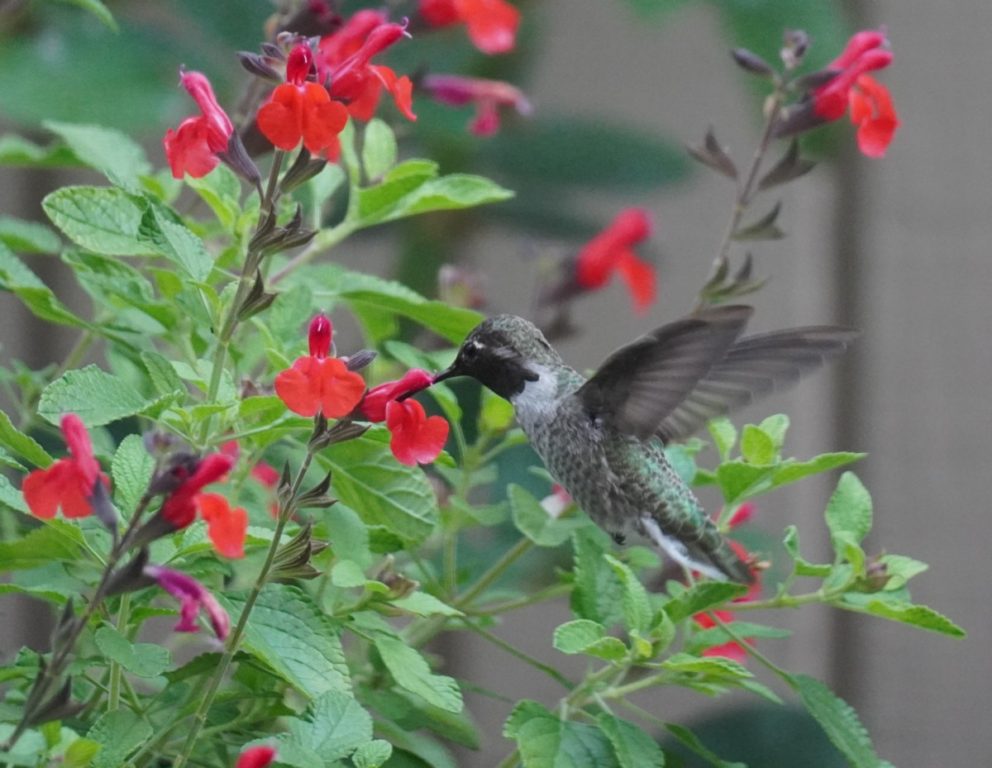
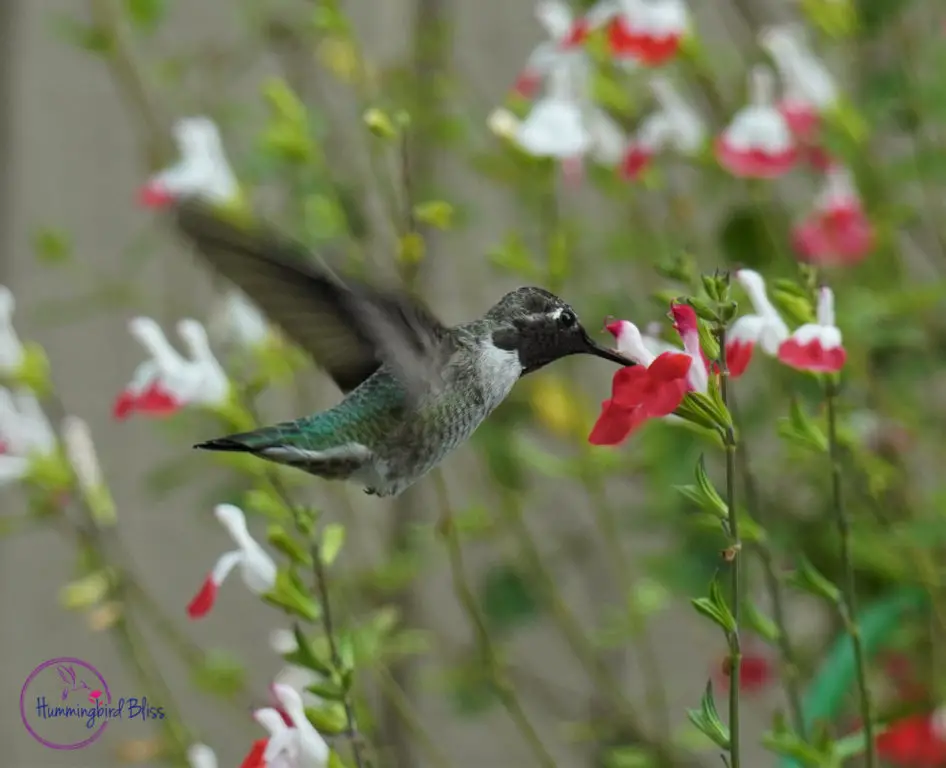
Hot Lips – Salvia microophylla
Combining the desired color and shape of a flower is the ultimate perfect union to attract hummingbirds. They will visit a variety of vividly colored tubular shaped flowering plants.
Colors aid in remembering objects.
When feeding from these flowers, the hummingbird must remember which flowers they have already visited and the time it takes for the flower to replace the harvested nectar.
To do this, hummingbirds must rely heavily on their memory for spatial awareness and minute visually identifiable features of each individual bloom.
See my article: Hummingbird Adaptation and Remarkable Ability to Locate Food
What Are The Best Hummingbird Plants in The West Coast?
- Cigar Plant (Cuphea ignea)
- Common Honeysuckle (Lonicera periclymenum)
- Coral or Trumpet Honeysuckle (Lonicera sempervirens)
- Egyptian Star Cluster (Pentas lanceolata)
- Friendship Sage (Amistad salvia)
- Hot Lips (Salvia microphylla)
- Hummingbird or Hardy Fuchsia (Fuschia magellanica ‘Aurea’)
- Japanese Honeysuckle (Lonicera japonica)
- Mexican Sage Bush (Salvia leucantha)
- Mystic Spires Blue Salvia (Sage Salvia Balsalmisp)
- Orange Cape Honeysuckle (Tecomaria capensis)
- Salmonberry (Rubus spectabilis)
- Trumpet Vine (Campsis radicans)
Cigar plant is the common name for Cuphea ignea, a highly favorable flower of the hummingbird diet. The visual appearance resembles a lit cigar from which the name was derived. Hummingbirds are attracted to the long orange tubular flowers that bloom nonstop year round in regions that do not have snow. This plant prefers sun to partial shade.
Common Honeysuckle is a fast-growing vine that prefers its roots in the shade while the shoots and new growth search for sunlight. Once the roots are established it is a drought tolerant vine. The blooms open ivory with a tinge of purple and then when it matures changes its color to yellow. This variety blooms mostly between May through June.
Most honeysuckle varieties bloom in the spring and continue to flower through September.
Coral or Trumpet Honeysuckle is a hardy vigorous climbing vine. The flowers present with an outside shell of coral or red. These slender tubular cluster flowers have yellow interiors and have no fragrance. Blooming season is in the early spring between March through June. They prefer sun to light or partial shade and require moderate watering. The blossoms attract hummingbirds and butterflies.
Egyptian Star Cluster or Star Flower is the common name for Pentas lanceolata, a perennial flower. This plant can be identified by the star-shaped pink dense cluster of single flowered stalks. It prefers full sun exposure, but can tolerate partial shade. Other varieties of flower clusters include red, magenta, lilac and white. This plant blooms in the summer and attracts hummingbirds and butterflies.
Friendship Sage is the common name for Amistad salvia and is a herbaceous perennial with large tubular deep purple flowers that has a long blooming season from early spring to the first winter frost in the fall. They prefer full sun and attract hummingbirds.
Hot Lips is the common name for Salvia microphylla and is a hardy drought tolerant bush that does well in full sun and well-drained soil. These flowers are white on top and red at the bottom resembling red lips, hence the name “Hot Lips”. In my experience, I have noticed hummingbirds are attracted and extremely territorial over “Hot Lips”.
Planting a multitude of colorful variations of this plant will produce spectacular territorial activity of entertainment.
Hummingbird or Hardy Fuchsia is the common name for Fuchsia magellanica ‘Aurea’. This deciduous evergreen shrub prefers full to partial shade and moist soil. Its lime green yellow foliage backdrop compliments the red magenta showy teardrop shaped flowers that open with and expose a purple interior. The blooming season is during the summer. These plants thrive in hanging baskets and containers or can be planted directly into the ground. It attracts hummingbirds and bees.
Japanese Honeysuckle is an invasive vigorous fast climbing vine that requires little maintenance and is the cousin to the Coral honeysuckle. This herbaceous plant prefers full sun and can grow rapidly, entangling itself into other vegetation and killing it if not properly pruned or maintained. The white bi-lobed tubular shaped flowers that turn yellow as they age produce fragrant nectar. The blossoms appear from late April through October.
During my childhood, I remember honeysuckles being one of my favorite perennial vines. I recollect tasting droplets of pure nectar from each blossom as I pretended to be a hummingbird enjoying the fruits of nature.
Mexican Sage Bush is a drought tolerant easy maintenance perennial shrub in the Salvia-Sages family. Their bicolor tubular flowers are velvety white and purple. The leaves are gray-green in color and with fuzzy white under layers. It prefers full sun to partial shade and blooms from spring through to the first frost. They attract hummingbirds and butterflies.
Mystic Spires Blue Salvia is a perennial shrub from the Salvia-Sage family with clusters of royal purple-blue flowers up and down the stalk. It thrives in full sun but can handle light shade and prefers moist well-drained soil that is watered regularly. They attract hummingbirds and butterflies.
Orange Cape Honeysuckle is an evergreen shrub or vine and a well-known attractant for hummingbirds. It has small red-orange clustered trumpet or tubular shaped flowers that prefers full sun. The flowers bloom in late summer attracting hummingbirds and butterflies.
It can be trained as an upright vine used to screen off sections of a yard or grown on a trellis or pergola for a specific outdoor design. Hummingbirds go crazy over this plant and by listening closely you will hear defensive territorial chirps in progress.
Salmonberry is found in the Pacific Northwest in moist coastal forests and is a member of the rose family. The saucer shaped flower has multiple centered yellow stamens encompassed by 5 magenta pink petals. They bloom from April to May. Its berries are similar in size and shape to a raspberry, but come in colors of yellow, orange and red. They flourish in open areas creating large thickets and attract hummingbirds and other birds.
Trumpet Vine or Trumpet Creeper is a vigorous invasive climber with huge flowers that enjoys full sun. The flower color combinations can be red, orange and yellow. Obviously, the red colored Trumpet Vine is better at attracting hummingbirds.
Climbing vines are used in a multitude of outdoor structures and provides a steady thick wall of foliage extending privacy to any outdoor space. They bloom in the summer and fall seasons and are an appealing visual exhibition to attract hummingbirds.
What Are The Best Hummingbird Plants in The Midwest?
- Bee Balm (Monarda)
- Cardinal Flower (Lobelia cardinalis)
- Coral or Trumpet Honeysuckle (Lonicera sempervirens)
- Crossvine (Bignonia capreolata)
- Egyptian starcluster (Pentas lanceolata)
- Hummingbird or Hardy Fuchsia (Fuschia magellanica ‘Aurea’)
- Japanese Honeysuckle (Lonicera japonica)
- Red Buckeye (Aesculus pavia)
- Red or Eastern Columbine (Aquilegia canadensis)
- Trumpet Vine (Campsis radicans)
- Weigela
Bee Balm is the common name for Monarda. It is a mildly invasive perennial plant with daisy shaped tubular petals and is able to flourish in full sun or partial shade. Bees, butterflies and hummingbirds are attracted to its various colors of red, pink, purple and white flowers.
Cardinal Flower is the common name for Lobelia cardinalis. It is perennial and well suited for sun, partial shade or shade, however requires moist to wet humus rich soil. The blossoms are vibrant red and attract hummingbirds.
Coral or Trumpet Honeysuckle blooms from March through June. It thrives in sun and partial shade. The small clusters of trumpet flowers are red, yellow or coral pink and attract butterflies and hummingbirds.
Egyptian Starcluster or Star Flower is the common name for Pentas lanceolata, a perennial flower. It has star-shaped pink dense clusters of single flowered stalks. It prefers full sun exposure, but can tolerate partial shade. Other varieties of flower clusters include red, magenta, lilac and white. This plant blooms in the summer. It attracts hummingbirds and butterflies.
Hummingbird or Hardy Fuchsia is the common name for Fuchsia magellanica ‘Aurea’. It is a deciduous perennial evergreen shrub that prefers full to partial shade with moist soil. Its lime green yellow foliage backdrop compliments the long slender red magenta tubular showy flowers that bloom during the summer until the first frost. It attracts hummingbirds and bees.
Japanese Honeysuckle is an invasive vigorous fast climbing vine that requires little maintenance and is the cousin to the Coral honeysuckle. This herbaceous plant prefers full sun and can grow rapidly, entangling itself into other vegetation and killing it if not properly pruned or maintained. The white bi-lobed tubular shaped flowers that turn yellow as they age produce fragrant nectar. The nectar attracts Ruby-throated hummingbirds and it blooms in May to June.
Red Buckeye is the common name for Aesculus pavia. This plant is a tree that reaches 15-20 feet in height that can be cultivated into a bush. It grows best in partial sun and shade. The red, yellow and combination two toned flowers bloom from March through May and attract butterflies and hummingbirds.
Warning: Seeds and young shoots of the Red Buckeye are poisonous to humans if consumed.
Red or Eastern Columbine is the common name for Aquilegia canadensis. This perennial evergreen is drought tolerant and prefers sandy well drained soils and a shade to partly shaded environment. The flowers bloom from February through July and are red, pink or yellow attracting hummingbirds, bees, butterflies and hawk moths.
Trumpet Vine is the common name for Campsis radicans. It prefers full sun and is a vigorously invasive climber with huge tubular red, orange and yellow trumpet flowers which attract hummingbirds and butterflies.
Weigela is a deciduous shrub that grows in full sun. This plant provides a large variety of colors, however the hummingbirds prefer the red and pink tones. The flower buds are 2-4cm clusters that bloom from April through June.
What Are The Best Hummingbird Plants in The East Coast?
- Bee Balm (Monarda)
- Cardinal Flower (Lobelia cardinalis)
- Coral or Trumpet Honeysuckle (Lonicera sempervirens)
- Crossvine (Bignonia capreolata)
- Fire Pink (Silene virginica)
- Japanese Honeysuckle (Lonicera japonica)
- Mexican Sage Bush (Salvia leucantha)
- Red Buckeye (Aesculus pavia)
- Red or Eastern Columbine (Aquilegia canadensis)
- Trumpet Vine (Campsis radicans)
- Wild Bergamot (Monarda fistulosa)
- Yellow jessamine (Gelsemium sempervirens)
Bee Balm is the common name for Monarda. It is a mildly invasive perennial plant with daisy shaped tubular petals and is able to flourish in full sun or partial shade. Bees, butterflies and hummingbirds are attracted to its various colors of red, pink, purple and white flowers.
Cardinal Flower is the common name for Lobelia cardinalis. It is perennial and well suited for sun, partial shade or shade, however requires moist to wet humus rich soil. The blossoms are vibrant red and attract hummingbirds.
Coral or Trumpet Honeysuckle blooms from March through June. It thrives in sun and partial shade. The small clusters of trumpet flowers are red, yellow or coral pink and attract butterflies and hummingbirds.
Crossvine is a climbing woody perennial evergreen vine that shows large orange-red trumpet shaped flowers with yellow throats. Prefers full sun, but can handle partial shade. They bloom in late winter to early spring. (NC) They attract hummingbirds.
Fire Pink is the common name for Silene virginica, a perennial wildflower. It prefers full sun to part shade and is tolerant to drought, clay or dry shallow rocky soil. It produces red flowers which attract the hummingbirds. This plant blooms from April through June.
Japanese Honeysuckle is an invasive vigorous fast climbing vine that requires little maintenance and is the cousin to the Coral honeysuckle. This herbaceous plant prefers full sun and can grow rapidly, entangling itself into other vegetation and killing it if not properly pruned or maintained. The white bi-lobed tubular shaped flowers that turn yellow as they age produce fragrant nectar. It blooms in April to August.
Mexican Sage Bush is a drought tolerant easy maintenance perennial shrub in the Salvia-Sages family. Their bicolor tubular flowers are velvety white and purple. The leaves are gray-green in color and have fuzzy white under layers. It prefers full sun to partial shade and blooms in late summer. They attract hummingbirds and butterflies.
Red Buckeye is the common name for Aesculus pavia. This plant is a tree that reaches 15-20 feet in height that can be cultivated into a bush. It grows best in partial sun and shade. The red, yellow and combination two toned flowers bloom from March through May and attract butterflies and hummingbirds.
Warning: Seeds and young shoots of the Red Buckeye are poisonous to humans if consumed.
Red or Eastern Columbine is the common name for Aquilegia canadensis. This perennial evergreen is drought tolerant and prefers sandy well drained soils and a shade to partly shaded environment. The flowers bloom from February through July and are red, pink or yellow attracting hummingbirds, bees, butterflies and hawk moths.
Trumpet Vine is the common name for Campsis radicans. It prefers full sun and is a vigorously invasive climber with huge tubular red, orange and yellow trumpet flowers which attract hummingbirds and butterflies.
Wild Bergamont is the common name for Monarda fistulosa. This perennial plant prefers sun to part shade however is adaptable and can be seen growing in dry fields, wet meadows and marshlands. The flowers are white, pink or purple with fragrant foliage and attract butterflies and hummingbirds. The blooming season is from May through September.
Yellow Jessamine is the state flower of North Carolina. It is a sweetly scented vine with large tubular shaped canary yellow flowers seen in small clusters. This hardy vine is wind tolerant. It blooms in February to April.
As the season of abundant flowering plants diminishes, other safe and inexpensive options of feeding your hummingbirds is to make your own hummingbird nectar. Hummingbird feeders are a great alternative resource for maintaining happy and frequent visitors to your outdoor area throughout the year.
See my article: Forget Commercial Hummingbird Food Try Making Homemade Nectar
What Flower Scents Attract Hummingbirds?
Hummingbirds do not have a strong sense of smell and must trust their vision to locate intensely colored blooming tubular flowers to guide them in seeking their food supply.
The long tubular vibrantly colored flowers that attract hummingbirds usually do not have a scent.
Hummingbirds rely more heavily on their sight than they do with their sense of smell. The shape and color of their preferred flowers provide them the desired nutrition to keep up with their demanding days of protecting their food sources.
Since hummingbirds do not have a great sense of smell, regularly cleaning their feeders is mandatory.
They can not identify the quality of homemade nectar by smell, only by texture and taste.
Bacteria and mold gather in their homemade nectar when it is not properly and regularly cleaned.
To learn about hummingbird diseases, see my article: Hummingbird Diseases: From Pathogens to Prevention
How Do I Make Homemade Hummingbird Nectar For My Feeder?
- Dissolve 1 part table sugar in 4 parts distilled water in a Pryex measuring cup by microwaving it in 30-second increments until the solution is dissolved.
- Bring nectar to room temperature before adding it to your feeder.
- Do not use organic sugar, honey or red dye.
An added benefit to homemade hummingbird food is that our friends are fed healthy non-synthetic food that is free of artificial coloring or preservatives.
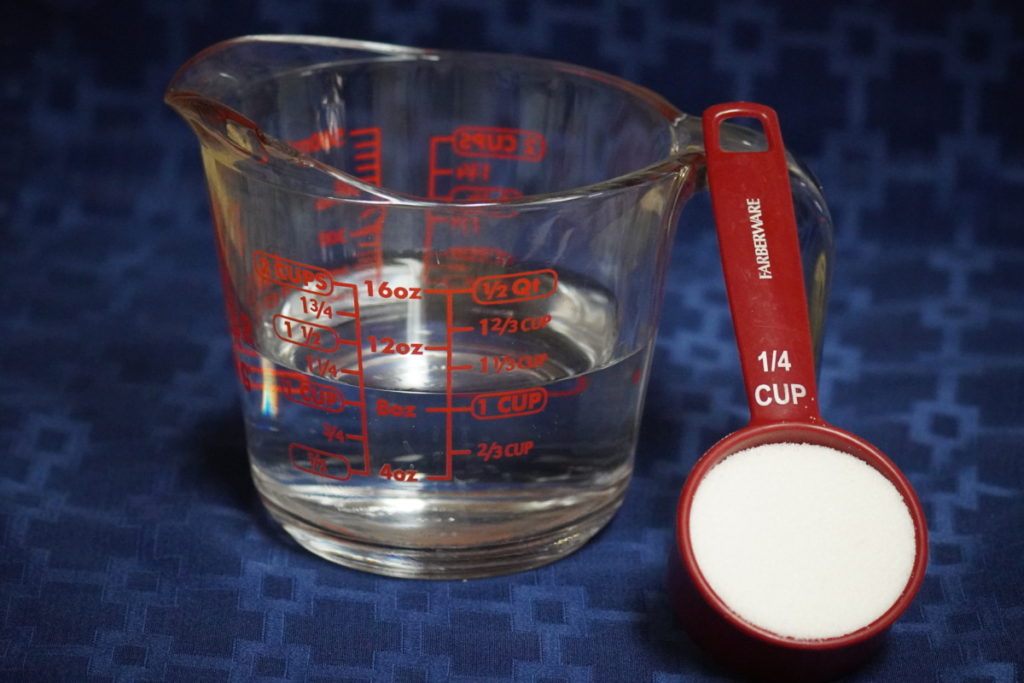
Beware! Many people have the inclination to gravitate towards “organic” labels believing this term means healthy or unadulterated. In the hummingbird world, organic doesn’t always mean better or safer when it comes to nectar solutions.
Use regular cane or table sugar, preferably with distilled water.
See my article: The One Thing You Need to Eliminate From a Hummingbird’s Diet
In my opinion, it is best to use the homemade hummingbird feeder food immediately and not refrigerate any leftover portions even though some may say it can last in the refrigerator for up to a week.
Bacteria and mold can grow in the homemade hummingbird feeder food being exposed daily to the sun and can cause health problems for hummingbirds.
Even if your feeder is not completely empty, discard the remaining old nectar and regularly clean and refill your feeder every 5 – 7 days.
Beak and tongue infections are common concerns and can be easily avoided with regularly cleaned feeders.
Fungal infections cause swollen tongues or growth spots on the beak. These obstacles make it hard for hummingbirds to consume food causing them to starve.
How Much Do Hummingbirds Eat?
Daily, Hummingbirds consume half of their body weight in nectar which is equal in weight to approximately 2 instant hot chocolate packets a day.
A Hummingbird’s daily protein consumption consists of thousands of insects. Hummingbirds feed on an average every 10 minutes.
Even though hummingbirds are noted for their mechanochemical efficiency (successfully converting food into energy for a hummingbird) they require a plethora of varied nutrients to maintain their daily existence. During daylight hours, hummingbirds are constantly searching for food to replenish their high energy and nutritional needs.
Hummingbirds do not use their tongue like a straw, but instead, are capable of lapping up nectar up to 15 times per second when they feed. They have to eat every 10 minutes and they excrete waste every 20 minutes; hence they are in constant search of food.
During the fall and winter migration seasons, hummingbirds are known to daily consume up to their full body weight. (approximately 4 oz). The more body fat they can pack before migrating, the better chance they will be successful in reaching their destination!
Happy hummingbird watching!
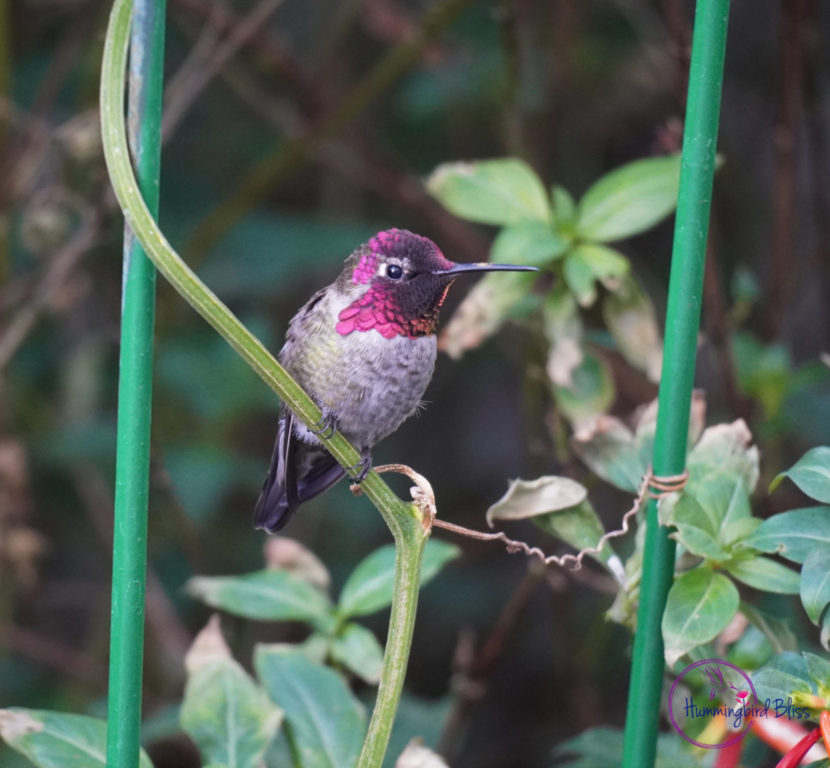
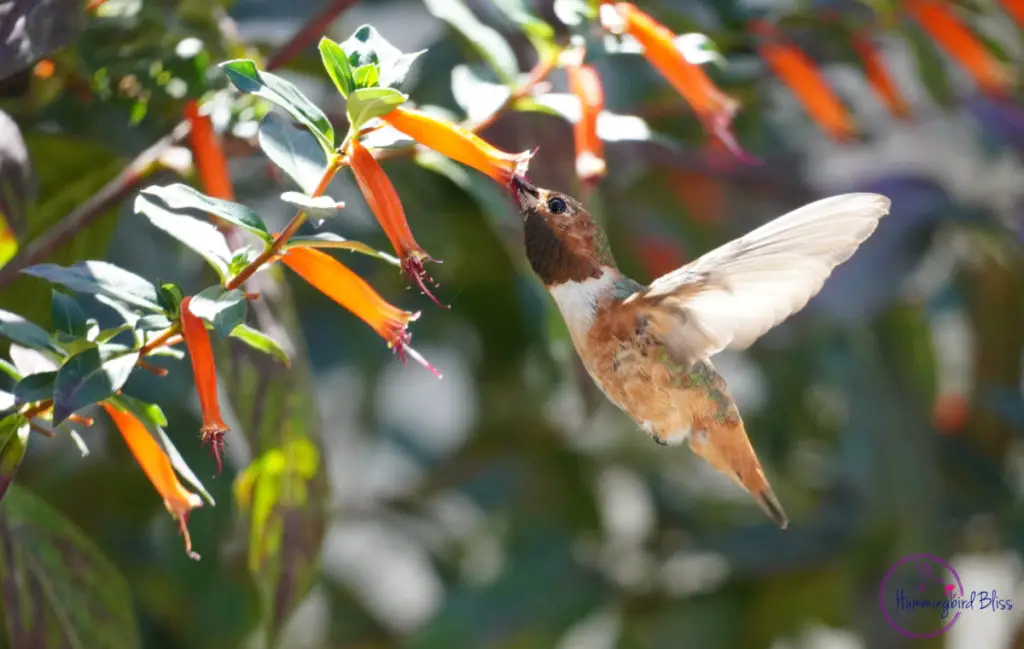
Backyard Visitors participates in affiliate programs which compensate us for referring traffic.

